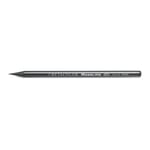Cretacolor Monolith Graphite Pencil

Cretacolor Monolith Graphite Pencil
- The real monolith: no wood, only graphite
- In six hardness grades: from HB to 9B
- Proven with graphic artists: for drawing and hatching
General Information
A monolith: the "Monolith". No wood. Just graphite
A piece of graphite shaped into a pencil: slightly shorter than a wood-cased pencil, but twice as heavy, comfortable in the hand with excellent balance, which it retains even when it has shrunk to half its size. Graphic artists are familiar with the full graphite pencil and need its fully opaque tip for drawing and hatching. In the harder gradations (HB, 2B), however, it is also a perfect, smooth and fluid writing tool. And: The heavy piece with the glossy clear lacquer surface is pleasing to the hand and also to the eye. It is best sharpened with sandpaper. If you use a sharpener, care is advised: The graphite comes off in very fine flakes and the pencil is ready to write and draw again after only a slight loss of material.
Since 1790: pencils from Burgenland
Cretacolor is one of the Austrian heirs to the famous former imperial and royal company "Koh-I-Noor", founded by Josef Hardtmuth. Koh-I-Noor" company founded by Josef Hardtmuth. The graphite pencil comes from one of the former Koh-I-Noor production plants in Hirm, Burgenland.
Pencils and accessories
"In pencil - if you were to make it yourself! Imagine humanity is gone: and you should make a pencil!!! - Magic!)" (Arno Schmidt)
It is wrongly named: there is no trace of lead in the pencil. This was only the case with a predecessor from the 15th century - Dürer, for example, drew with lead/tin alloyed leads. The history of the pencil in the modern sense of the word only began in the 17th century. It was then that the English graphite mines were discovered and the material, whose solid structure (the lattice layers of graphite easily slide off each other under pressure) made it ideal for use in pencil leads, was mined for the first time. However, graphite leads sawn from a solid piece were precious. This only changed when the Frenchman Nicolas Jacques Conté and the Austrian Josef Hardtmuth developed a method of producing graphite leads using ceramics at the end of the 18th century. They mixed graphite dust with clay and fired the leads in a kiln, whereby the hardness of the lead could be determined by the amount of clay and the firing time.
The degree of hardness is indicated according to the English designations - and from soft to hard - with the abbreviations B (black), HB (hard-black), F (firm) and H (hard), whereby the B and H variants are additionally differentiated by numbers from 2-9 (the higher the number, the softer or harder the lead).
Product Information
Article Number 27299
- The real monolith: no wood, only graphite
- In six hardness grades: from HB to 9B
- Proven with graphic artists: for drawing and hatching
One pencil each in the following hardnesses: HB, 2B, 4B, 6B, 8B, 9B.
Pure graphite pencil without wooden case. Comes in a tin case. Grade HB (medium), 2 B (soft) or 8 B (very soft). Length 14.5 cm. Weight 10 g.
Have a question?
If you have a question concerning this product you are welcome to contact us. For this your E-Mail program will open.
Customer Service
Whether its advice, spare parts, or special requests - all your questions and concerns are handled personally and thoroughly by our customer service.
You can contact us anytime at info@manufactum.dk

